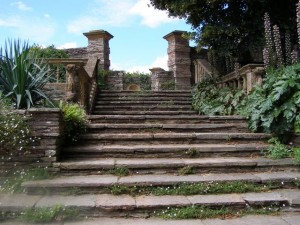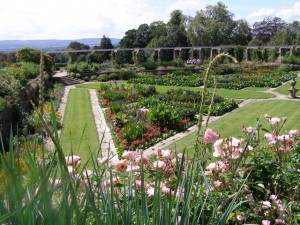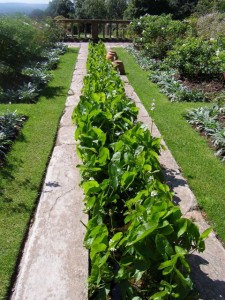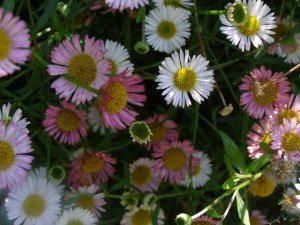
Garden designers like to talk about hard and soft landscaping. These two divide roughly into stone and flowers and in an historical context, Edwin Lutyens, architect, was to the first as the booted and bespectacled Gertrude Jekyll was to the second. She was 46 to his 21 when their collaboration started and the two go in hand with the Edwardian ‘Arts and Craft’ movement. They made sumptuous new gardens and over those that remain a zephyr breeze of stockbroker wealth and confidence still blows.
Hestercombe Garden, Cheddon Fitzpaine in Somerset has that breeze in updrafts. Both grounds and gardens have had lottery funding and the flowerbeds, in particular, have undergone a mighty facelift. Jekyll’s plantings have been restored from original plans found in the potting shed . Myopia had forced her to turn from watercolours and embroidery to the broader palette of planting design. A cursory glance at any of her planting plans or writing shows that she knew her plants intimately. Add to that the influences of a sense of the right place for a plant and theories on colour and it is easy to understand why she has never gone out of fashion.
[caption id="attachment_703" align="alignleft" width="300" caption="Great Plat"]

[/caption]
At Hestercombe the first impact is made by the actual layout, conjuring to mind the ambition of a Borgia Pope in that it is both showy and a backdrop for having a party. Below the Victorian terrace, the garden sits proud of the Somerset landscape on stone bones with a wall some 3 metres high and these ramparts are hidden behind figs and roses. Along the top, the South Walk has a pergola that stretches the width of the formal garden . This pergola is roughly 83 metres long and has pillars of stone – columns alternating with rectangles to break the length with massy timber joists on top. Vines and honeysuckles have been trained up wires to clothe the structure.
Looking back towards the house there is a large sunken garden – this is the Great Plat, saved from being tarmaced over 30 years ago. The flowerbeds are triangular, stone-edged with an exuberant planting of bedding plants. Bedding out is a form of gardening that is labour intensive involving taking out plants that have finished flowering and replacing them seasonally. It is not fashionable but climate change may bring it back as the gardener struggles with water-logged soil.
[caption id="attachment_704" align="alignleft" width="225" caption="rill planted with Sagittaria latifolia"]

[/caption]
The Great Plat is embraced by two grass walkways that border two long rills. These are long and narrow stretches of water, bounded by stone and heavily planted with a monoculture of water-loving plants. This is definitely an idea to snap up and take away, particularly copying the restraint of only having one type of plant. The water in the rills is fed by a fountain to the north and a cascade to the southern end. If you aim to copy, make sure that your water is circulated by a pump.
Lutyens added an Orangery, a raised Dutch garden, flights of steps both linear and composed of circles, which look particularly showy and then there is the pair of rills that frame either side of the upper reaches of the garden. There are a plethora of level changes and stone ever present. Without needing to go for the full Borgia effect, a few tricks can be learnt from all the hard landscaping at Hestercombe: – break the mood in different parts of your garden in the way that paving materials are laid. Even if you are using York paving, consider the change from formality with a regular size and laying pattern of stone to informality. Altering the shapes from rectangular blocks to crazy paving will make a natural break.
[caption id="attachment_705" align="alignleft" width="300" caption="Erigeron karvinskianus"]

[/caption]
As far as Hestercombe is concerned, what could be labelled as ostentatious is saved by sure planting – the stone walls do not get away with dominating because small, unflashy plants such as fleabane (
Erigeron karvinskianus) have been allowed to seed throughout.
 Garden designers like to talk about hard and soft landscaping. These two divide roughly into stone and flowers and in an historical context, Edwin Lutyens, architect, was to the first as the booted and bespectacled Gertrude Jekyll was to the second. She was 46 to his 21 when their collaboration started and the two go in hand with the Edwardian ‘Arts and Craft’ movement. They made sumptuous new gardens and over those that remain a zephyr breeze of stockbroker wealth and confidence still blows.
Hestercombe Garden, Cheddon Fitzpaine in Somerset has that breeze in updrafts. Both grounds and gardens have had lottery funding and the flowerbeds, in particular, have undergone a mighty facelift. Jekyll’s plantings have been restored from original plans found in the potting shed . Myopia had forced her to turn from watercolours and embroidery to the broader palette of planting design. A cursory glance at any of her planting plans or writing shows that she knew her plants intimately. Add to that the influences of a sense of the right place for a plant and theories on colour and it is easy to understand why she has never gone out of fashion.
[caption id="attachment_703" align="alignleft" width="300" caption="Great Plat"]
Garden designers like to talk about hard and soft landscaping. These two divide roughly into stone and flowers and in an historical context, Edwin Lutyens, architect, was to the first as the booted and bespectacled Gertrude Jekyll was to the second. She was 46 to his 21 when their collaboration started and the two go in hand with the Edwardian ‘Arts and Craft’ movement. They made sumptuous new gardens and over those that remain a zephyr breeze of stockbroker wealth and confidence still blows.
Hestercombe Garden, Cheddon Fitzpaine in Somerset has that breeze in updrafts. Both grounds and gardens have had lottery funding and the flowerbeds, in particular, have undergone a mighty facelift. Jekyll’s plantings have been restored from original plans found in the potting shed . Myopia had forced her to turn from watercolours and embroidery to the broader palette of planting design. A cursory glance at any of her planting plans or writing shows that she knew her plants intimately. Add to that the influences of a sense of the right place for a plant and theories on colour and it is easy to understand why she has never gone out of fashion.
[caption id="attachment_703" align="alignleft" width="300" caption="Great Plat"] [/caption]
At Hestercombe the first impact is made by the actual layout, conjuring to mind the ambition of a Borgia Pope in that it is both showy and a backdrop for having a party. Below the Victorian terrace, the garden sits proud of the Somerset landscape on stone bones with a wall some 3 metres high and these ramparts are hidden behind figs and roses. Along the top, the South Walk has a pergola that stretches the width of the formal garden . This pergola is roughly 83 metres long and has pillars of stone – columns alternating with rectangles to break the length with massy timber joists on top. Vines and honeysuckles have been trained up wires to clothe the structure.
Looking back towards the house there is a large sunken garden – this is the Great Plat, saved from being tarmaced over 30 years ago. The flowerbeds are triangular, stone-edged with an exuberant planting of bedding plants. Bedding out is a form of gardening that is labour intensive involving taking out plants that have finished flowering and replacing them seasonally. It is not fashionable but climate change may bring it back as the gardener struggles with water-logged soil.
[caption id="attachment_704" align="alignleft" width="225" caption="rill planted with Sagittaria latifolia"]
[/caption]
At Hestercombe the first impact is made by the actual layout, conjuring to mind the ambition of a Borgia Pope in that it is both showy and a backdrop for having a party. Below the Victorian terrace, the garden sits proud of the Somerset landscape on stone bones with a wall some 3 metres high and these ramparts are hidden behind figs and roses. Along the top, the South Walk has a pergola that stretches the width of the formal garden . This pergola is roughly 83 metres long and has pillars of stone – columns alternating with rectangles to break the length with massy timber joists on top. Vines and honeysuckles have been trained up wires to clothe the structure.
Looking back towards the house there is a large sunken garden – this is the Great Plat, saved from being tarmaced over 30 years ago. The flowerbeds are triangular, stone-edged with an exuberant planting of bedding plants. Bedding out is a form of gardening that is labour intensive involving taking out plants that have finished flowering and replacing them seasonally. It is not fashionable but climate change may bring it back as the gardener struggles with water-logged soil.
[caption id="attachment_704" align="alignleft" width="225" caption="rill planted with Sagittaria latifolia"] [/caption]
The Great Plat is embraced by two grass walkways that border two long rills. These are long and narrow stretches of water, bounded by stone and heavily planted with a monoculture of water-loving plants. This is definitely an idea to snap up and take away, particularly copying the restraint of only having one type of plant. The water in the rills is fed by a fountain to the north and a cascade to the southern end. If you aim to copy, make sure that your water is circulated by a pump.
Lutyens added an Orangery, a raised Dutch garden, flights of steps both linear and composed of circles, which look particularly showy and then there is the pair of rills that frame either side of the upper reaches of the garden. There are a plethora of level changes and stone ever present. Without needing to go for the full Borgia effect, a few tricks can be learnt from all the hard landscaping at Hestercombe: – break the mood in different parts of your garden in the way that paving materials are laid. Even if you are using York paving, consider the change from formality with a regular size and laying pattern of stone to informality. Altering the shapes from rectangular blocks to crazy paving will make a natural break.
[caption id="attachment_705" align="alignleft" width="300" caption="Erigeron karvinskianus"]
[/caption]
The Great Plat is embraced by two grass walkways that border two long rills. These are long and narrow stretches of water, bounded by stone and heavily planted with a monoculture of water-loving plants. This is definitely an idea to snap up and take away, particularly copying the restraint of only having one type of plant. The water in the rills is fed by a fountain to the north and a cascade to the southern end. If you aim to copy, make sure that your water is circulated by a pump.
Lutyens added an Orangery, a raised Dutch garden, flights of steps both linear and composed of circles, which look particularly showy and then there is the pair of rills that frame either side of the upper reaches of the garden. There are a plethora of level changes and stone ever present. Without needing to go for the full Borgia effect, a few tricks can be learnt from all the hard landscaping at Hestercombe: – break the mood in different parts of your garden in the way that paving materials are laid. Even if you are using York paving, consider the change from formality with a regular size and laying pattern of stone to informality. Altering the shapes from rectangular blocks to crazy paving will make a natural break.
[caption id="attachment_705" align="alignleft" width="300" caption="Erigeron karvinskianus"] [/caption]
As far as Hestercombe is concerned, what could be labelled as ostentatious is saved by sure planting – the stone walls do not get away with dominating because small, unflashy plants such as fleabane (Erigeron karvinskianus) have been allowed to seed throughout.
[/caption]
As far as Hestercombe is concerned, what could be labelled as ostentatious is saved by sure planting – the stone walls do not get away with dominating because small, unflashy plants such as fleabane (Erigeron karvinskianus) have been allowed to seed throughout.
